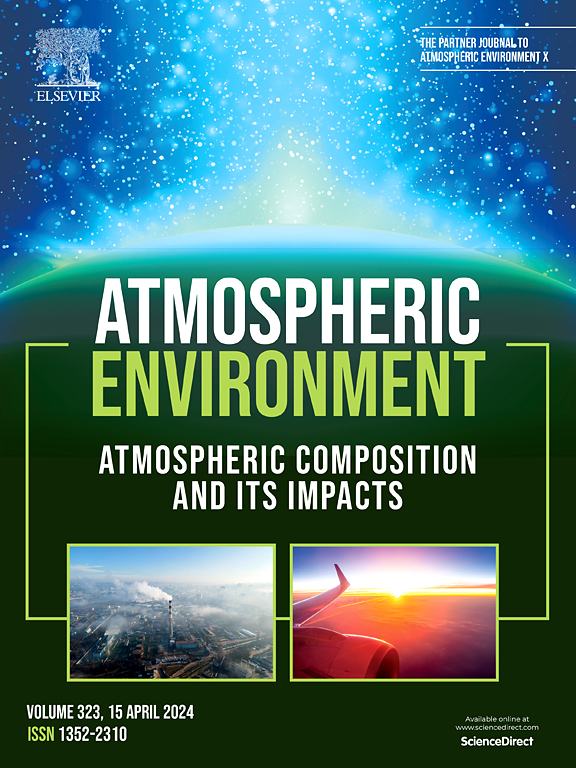Long-range transport influence on wintertime submicron aerosol chemical composition from simultaneous measurements in Lithuania and Southern Sweden
IF 4.2
2区 环境科学与生态学
Q2 ENVIRONMENTAL SCIENCES
引用次数: 0
Abstract
Due to the large extent of seawater surface over the globe, aerosol particles spend significant time being transported over this type of surface. Therefore, global aerosol circulation is largely impacted by the processes particles undergo during long-range transport overseas. In this study, we investigated submicron aerosol (PM1) chemical composition changes during long-range transport events over the southern Baltic Sea across two sites in Sweden (Hyltemossa) and Lithuania (Preila). The chemical composition was determined simultaneously using mass spectroscopy (time-of-flight aerosol chemical speciation monitor (ToF-ACSM)) in Hyltemossa and quadrupole ACSM (Q-ACSM) in Preila and filter-based optical (AE33 in Hyltemossa and AE31in Preila) methods. The aim of the study was to investigate the effect of long-range air mass transport over the sea on PM1 chemical composition at the two remote background sites in the southern Baltic Sea region. The campaign average PM1 concentration in Preila (11.2 μg/m3) was higher than in Hyltemossa (6.3 μg/m3). Yet, during long-range transport events, PM1 concentration in Preila, downwind, was 40% lower (2.5 μg/m3) than in Hyltemossa (4.3 μg/m3), upwind, suggesting aerosol removal and dilution processes over the sea. We used the meteorological and spatial parameters from backward trajectory analysis to categorise the long-range air mass transport events across the two sites. Then the combinations of dilution, wet and dry deposition, emissions over land and other processes were labelled as the sea transport effect, wet deposition processes and land-atmosphere interaction. The results showed that during the events when air mass trajectories stretched from west to east from over Hyltemossa to Preila without precipitation along the path, the PM1 concentration decreased on average by 50%. The addition of precipitation resulted in a larger decrease (70%) of PM1 concentration. However, during the events with precipitation when air mass trajectories passed over a continental area before arriving at the downwind site, the net decrease was the lowest (27%). The lowest relative change in PM1 concentration during those events suggests the potential uptake of pollutants into the air mass over land with more significant anthropogenic pollution sources. Our approach allows us to quantitively assess the mitigating effects of sea transport, wet deposition processes and the opposite effect when air mass is advected over land on PM1 concentration using the proposed classification based on meteorological and spatial parameters of HYSPLIT backward trajectories.
立陶宛和瑞典南部同时测量的远程输送对冬季亚微米气溶胶化学成分的影响
由于全球的海水表面面积很大,气溶胶粒子在这种表面上的运输时间很长。因此,全球气溶胶环流在很大程度上受到粒子在海外远距离传输过程的影响。在这项研究中,我们研究了在波罗的海南部穿越瑞典(Hyltemossa)和立陶宛(Preila)两个地点的远程运输事件中亚微米气溶胶(PM1)化学成分的变化。采用质谱法(飞行时间气溶胶化学形态监测仪(ToF-ACSM))和四极杆ACSM法(Q-ACSM)以及滤光片光学法(Hyltemossa中的AE33和Preila中的ae31)同时测定了Hyltemossa和Preila中的化学成分。本研究的目的是调查远距离海上气团输送对波罗的海南部地区两个偏远背景站点PM1化学成分的影响。普雷拉市的运动平均PM1浓度(11.2 μg/m3)高于Hyltemossa市(6.3 μg/m3)。然而,在长距离输送过程中,下风的Preila的PM1浓度(2.5 μg/m3)比上风的Hyltemossa的PM1浓度(4.3 μg/m3)低40%,表明海上有气溶胶去除和稀释过程。利用后向轨迹分析的气象和空间参数对两个站点的远程气团输送事件进行了分类。然后将稀释、干湿沉降、陆地排放和其他过程的组合标记为海洋运输效应、湿沉降过程和陆地-大气相互作用。结果表明,当气团轨迹从Hyltemossa上空向Preila上空自西向东伸展而路径上无降水时,PM1浓度平均下降50%;降水量的增加导致PM1浓度下降幅度较大(70%)。然而,在有降水的事件中,当气团轨迹在到达下风点之前经过大陆区域时,净减少最小(27%)。在这些事件期间,PM1浓度的最低相对变化表明,在具有更显著的人为污染源的陆地上空,污染物可能被吸收到气团中。我们的方法允许我们使用基于HYSPLIT反向轨迹的气象和空间参数提出的分类,定量评估海洋运输、湿沉积过程以及气团平流到陆地时对PM1浓度的相反影响的缓解作用。
本文章由计算机程序翻译,如有差异,请以英文原文为准。
求助全文
约1分钟内获得全文
求助全文
来源期刊

Atmospheric Environment
环境科学-环境科学
CiteScore
9.40
自引率
8.00%
发文量
458
审稿时长
53 days
期刊介绍:
Atmospheric Environment has an open access mirror journal Atmospheric Environment: X, sharing the same aims and scope, editorial team, submission system and rigorous peer review.
Atmospheric Environment is the international journal for scientists in different disciplines related to atmospheric composition and its impacts. The journal publishes scientific articles with atmospheric relevance of emissions and depositions of gaseous and particulate compounds, chemical processes and physical effects in the atmosphere, as well as impacts of the changing atmospheric composition on human health, air quality, climate change, and ecosystems.
 求助内容:
求助内容: 应助结果提醒方式:
应助结果提醒方式:


